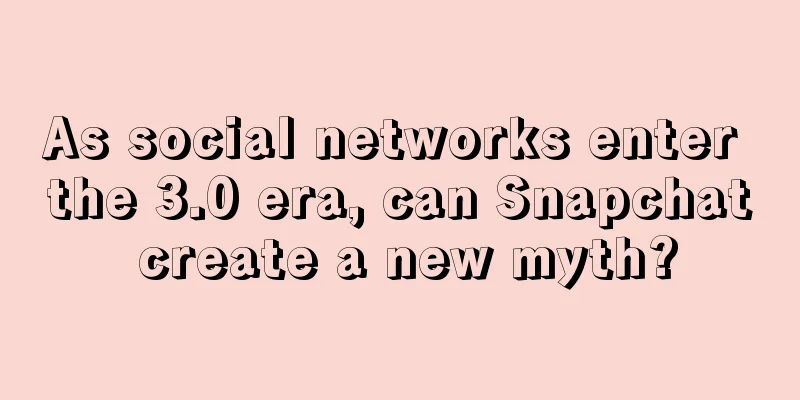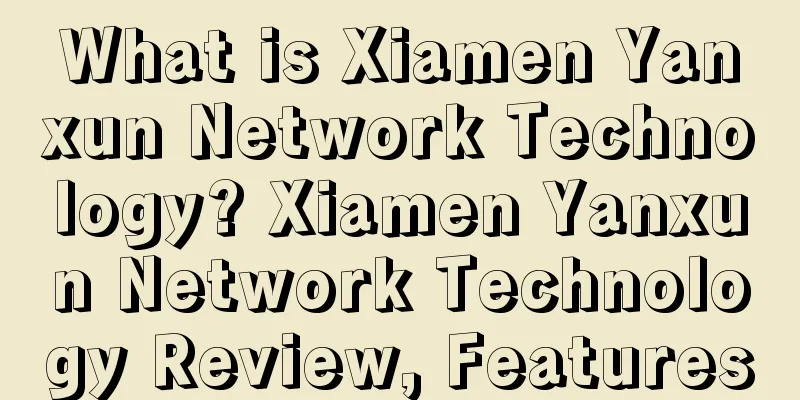As social networks enter the 3.0 era, can Snapchat create a new myth?

|
SNS ' decade-long career as the leader of Web 2.0 has not only reshaped the form of the Internet, but has also completely changed the perspective and way everyone views the world. However, the rapid growth with rolling dividends is destined to be difficult to become the norm. When "sense of participation" is no longer a unilateral criterion for measuring the success or failure of a social network, and when "commercial value" increasingly becomes the focus of capital and brands, where should the upstart SNS, which has been at the forefront of the times for a decade, go?
The answer is more optimistic than expected. The SNS platforms that have bid farewell to the growth dividend period and entered the mature stage have shown strong business vitality, far exceeding the most optimistic expectations of most traditional capital. Among them, Snapchat, a young social network service provider that regards "disappearing after reading" as its core competitiveness and emphasizes "minimizing applications", is one of the outstanding examples.
The “Read and Burn” app started at the height of the storm
At Christmas 2011, a large number of middle school students in Europe and North America received a hot gift:
The iPhone 4S that just came out . Or the iPhone 4 that's a step down and on sale at a special discount.
Facing the 300,000-pixel camera on the front of this phone , these young users who were holding the mobile Internet in their hands for the first time quickly realized the practical significance of the "selfie" function - taking selfies anytime and anywhere was just the beginning, and sending these photos taken at will to friends was the real need of Web2.0 natives. Obviously, Facebook, which even parents were using, was definitely not a good choice. A selfie exchange platform that valued personal privacy and could keep secrets for these restless users became a rigid demand of that era.
Thus, Snapchat (called Picaboo at that time) came on the scene. With its simple operation of "click to shoot" and the "disappear after reading" function that was easy to understand, this simple app quickly became popular in the Western youth community: in January 2012, Snapchat (Picaboo), which had only been online for half a year, had a daily active user increased from thousands to more than 20,000. "Disappear after reading" became the most popular social code for Western minors at that time. Snapchat's journey to dominate the youth SNS started from then on.
This is just the beginning. Everything that happened afterwards proved once again that if you seize the opportunity and optimize the functions for the user group, even if it seems to be a fleeting trend, you can still create outstanding winners: "Burn after reading" did not turn Snapchat into a short-lived platform. On the contrary, as of Q3 2021, Snapchat already has 306 million daily active users worldwide, 5 billion Snaps are continuously sent every day, and Snapchat users have more than 6 billion AR interactions every day.
Take the United States as an example. Today, Snapchat accounts for about half of all smartphone users in the United States. In addition, more than 90% of young people aged 13 to 24 in the United States open Snapchat every day. Compared with "traditional" SNS platforms such as Facebook, Instagram and Messenger, the size of Snapchat's young users (aged 13 to 17) is twice the total of these three. In addition, in Europe, the Middle East, Australia and India, Snapchat also has an astonishing number of young fans.
But that’s not all. After a decade of development, Snapchat’s audience is no longer limited to Europe and the United States, and its selling point is not just selfies. As an SNS platform, its product promotion value is enough to make most brands smile.
More than just Snapchat for the young
Like many popular apps that were born on campus and grew up in California , conquering the US market is only the first step for Snapchat to reach the top. Going global and gaining the favor of global target users means real success - and Snapchat has really done it.
Without going into too much detail, just look at the performance of the Middle East market and you will understand how great Snapchat's globalization strategy is: among young people aged 13 to 24 in the UAE, 60% are loyal users of Snapchat, and in Saudi Arabia, the proportion of users aged 13 to 34 directly exceeds 90%; considering that the entire Middle East has more than 300 million Internet users, and Generation Z and Millennials occupy an unshakable position in the e-commerce consumer market, the brand promotion value of Snapchat in the Middle East Internet world is naturally self-evident.
Take e- commerce as an example. Like most SNS platforms that have established a foothold in the international Internet environment , Snapchat has diversified advertising packaging forms and provides a one-stop solution for the overseas marketing of various products: whether it is pre-promotion through daily advertising in the early stage of promotion, or increasing new users and improving retention rate through various advertising plans during the formal promotion period, or attracting registered users to convert into paying members and monetizing non-paying users in the subsequent operation period, Snapchat provides a complete solution including advertising creativity, delivery strategy and targeting to meet customers' promotion demands at different stages - whether it is a video blog or a novel reading App website, you can find a complete product promotion plan on Snapchat.
Not only that, in addition to the non-skippable Commercial Ads (vertical full-screen video ads) in the first 6 seconds, the highly acclaimed Story Ads (similar in form to brand zones, presented in the Stories section, one of the five core sections of Snapchat) and Collection Ads that present multiple product information at once (supporting multi-dimensional display of application functions and App jump downloads), as a social platform that started out as a selfie platform, Snapchat will naturally not ignore the advertising potential of this core selling point - that's right, the Snapchat AR filters that have been well received by platform users represent more than just entertainment functions.
Judging from the difficulty of users getting started and the actual landing effect, Snapchat AR filters are undoubtedly one of the most successful examples of augmented reality technology moving towards practical application at this stage. Since its launch, Snapchat users of the millennial and Generation Z generations have created countless dazzling new tricks through various AR filters. At the same time, the product marketing and promotion potential of Snapchat AR filters has also begun to become increasingly apparent.
For example, users can use interactive game filters to interact deeply with brand-related content characters (or icons), and then record short videos with brand promotion BGM to share with Snapchat friends, thereby igniting spontaneous dissemination and promotion. Most importantly, these seemingly complex and time-consuming production processes can all use Snapchat's backend Snap publisher to generate creativity, and a professional team can provide material solutions based on brand needs. In other words, in order for brands to awaken the promotion trend of secondary creation among young user groups, Snapchat has already made thorough preparations with AR filters.
Thanks to its comprehensive service functions and advanced marketing methods driven by cutting-edge technology, Snapchat has been favored by more and more brands in recent years for product overseas promotion. Among them are well-known consumer electronics brands such as Samsung, mainstream fashion and sports brands such as Puma, and even Western fast food brand Burger King and fashion e-commerce ZAFUL, all of which have achieved outstanding marketing and promotion results in the e-commerce market in the Middle East.
According to Snapchat's statistics in 2020, the purchasing power of millennials and Generation Z worldwide is at least over 1 trillion US dollars; and on Snapchat, AR filters have maintained extremely high popularity in the Middle East throughout the year, and when shopping festivals that are in line with international consumption habits come, they have won unprecedented popularity . During the recent Ramadan in 2021, Snapchat users from Saudi Arabia viewed AR filters more than 90 billion times. Considering the attention of young users in the Middle East to Snapchat, I believe there is no need to emphasize how much return the launch of customized products means.
That’s not all. The success in the Middle East market is only part of Snapchat’s internationalization strategy. From Mexico to India, from Latin America to Oceania, over the past decade, Snapchat has successfully won the favor of a large number of young users around the world, and has successfully become one of the preferred marketing platforms for global brands to go global.
From "burn after reading" to the interactive revolution of AR vision
The online social network built through real-life friendships is the core element of Snapchat's success. It is not difficult to imagine that this atmosphere of like-minded close friends will undoubtedly be of great help to the brand communication and marketing model that spreads from point to surface.
According to official statistics from the Snapchat platform, 91% of Snapchatters currently use video podcast app services every day. About 65% of Snapchatters said that their usage habits would prompt their relatives and friends to purchase the same service applications, and another 55% of Snapchatters believed that their behavioral examples would have a direct impact on the consumption behavior of their close friends.
At the same time, 73% of Snapchatters claimed that they would actively purchase video podcast app services at least once through the platform's brand promotion, and 54% of Snapchatters said they would repurchase twice or more; among the 13-17 year old Snapchat user group, 46% would save pocket money to buy podcast programs they were interested in, and among the 24-35 year old Snapchat user group (a considerable number of whom are loyal fans who have registered for many years), 43% keep an eye on brand promotional content on the platform - this shows that Snapchat today has formed an excellent centripetal force among the platform's registered user groups. This initiative to actively understand and promote brands based on trust in the platform is also one of Snapchat's core competitive advantages as a product promotion platform.
The young generation who used to share private messages on Snapchat ten years ago have now grown up and have begun to return their mature consumption power to Snapchat, which accompanied them through their adolescence. Not only that, ten years later, Snapchat, which has always insisted on "walking with the younger generation", is still the first choice of social network for contemporary young people - this vibrant tone of "forever young, always full of tears" is the most noteworthy advantage of Snapchat as a brand marketing and promotion platform.
Snapchat’s brand promotion journey is not over yet. Snapchat Burn after reading AR |
Recommend
The "Snowstorm of the Century" forced eBay to re-issue seller protection, and sellers said it was too difficult!
It is reported that the northeastern United State...
SHEIN has invested hundreds of millions of dollars to help designers build their own brands. In the past three years, it has empowered more than 4,600 designers.
Recently , fashion cross-border e-commerce SHEIN ...
Another 200 million yuan investment! R&D in Nanshan, Shenzhen, started in the new year
The cross-border e-commerce industry was really d...
Shrinking by 20%, how is Amazon's store acquisition business doing this year?
Although the growth of the e-commerce industry ha...
What is Nadine West? Nadine West Review, Features
Nadine West is an American women's clothing s...
What is FashionWare? FashionWare Review, Features
<span data-docs-delta="[[20,{"gallery"...
Amazon fully upgrades its logistics system! Listing rankings will also change
In the United States, Amazon operates a national ...
TikTok also wants to copy homework? Learn from AliExpress and launch a "full hosting" model
The latest news is that following AliExpress and ...
TRO as soon as next week! A group of sellers may be sued for infringement before PD
The cooling of the cross-border e-commerce market...
Tokopedia is gaining momentum, with 70% of sellers seeing a 133% sales increase
As a pioneer in Indonesian e-commerce, Tokopedia ...
Anker also stumbled! More than 40,000 products were found to have problems
Product safety is no small matter, and Anker has ...
Check yourself! This dangerous product has been urgently recalled on Amazon and other platforms
Recently, the U.S. Consumer Product Safety Commis...
French non-food prices soar, cheaper online channels attract attention
According to a comparative study by Le Dénicheur,...
What is ZapERP Inventory? ZapERP Inventory Review, Features
ZapERP Inventory manages inventory across multiple...
Cross-border trading is ushering in important opportunities! Sellers can’t sit still
At present, the internal competition in the cross...









